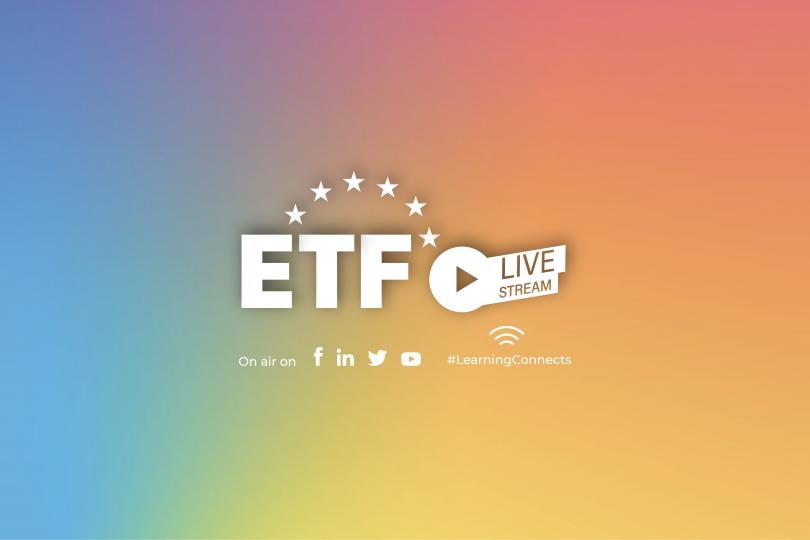
Leaving no-one behind: why digital inclusion is new for lifelong learning
In a month where the European Training Foundation’s communications team has been highlighting “digital skills for inclusion” ETF brought together three top international speakers to explore what digital inclusion means in practice for students, teachers – and lifelong learners.
In a video session Wednesday streamed live over various platforms (and available to watch now via the ETF’s Facebook, YouTube and LinkedIn pages) “Digital Inclusion: Sharing priorities, making it real” speakers from the International Labour Organisation (ILO) and the ETF identified including the needs of vulnerable and marginalised groups in the concept of online and digital learning and teaching resources from the very beginning of the design process as one of the key pillars of digital inclusion.
Organised by the ETF jointly with the International Training Centre of the ILO, which in July 2021 hosted a Digital Inclusion Summit, the conversation kicked off around ideas and conclusions from that top international meeting that have been summarised in a new book: “4-42: A digital inclusion book: Leaving no one behind.”
Tom Wambeke, Chief Learning Innovation, at the ITC ILO, said the summit, “shook up four radical ideas to foster an interdisciplinary, solution-oriented mindset moving towards: re-imagining digital literacy, advancing 360 degree inclusion, designing for humans, and accelerating momentum.”
The idea of the summit was, “to bring different actors together into an inter-disciplinary dialogue…. There were delegates from UNESCO, ITO, ILO, and those working at the policy and grassroots level,” Tom said.
The summit resulted in 42 tips centred around the four digital inclusion concepts. This idea was, he explained, borrowed from the US Westcoast Burning Man festival, which is based upon 10 principles focused around community, art, self-expression and self-reliance.”
“We are talking about human ‘mindware’ not [computer] hardware or software – it is about changing mindsets. It is a moment - in this fast-food information society - to reflect on each of these 42 tips to prompt conversation and reflection,” he said, quipping that if people wanted to know why there were 42-tips they should read Douglas Adams’ Hitchhiker’s Guide to the Galaxy “to find the answer to that one!”
The book that resulted was “not a ‘to-do’ list,” he stressed, “but more an artistic work to think outside the box in order to foster digital inclusive future.”
Karine Sonigo, a Skills Digitalisation Specialist at the ILO, said there was a growing interest in digital skills for inclusion coupled with the rising awareness of the “general impact” digitalisation and the use of technology was having on people’s lives and workplaces.
“Mega-trends, such as climate change and demographics are driving new trends for people to live in the digital economy with – for example - health, finance, administration all now accessible online.”
This begged a global question, she said. “In order to include everyone and not to further exclude individuals, we need an inclusive user-centric approach to workplaces and society in general.”
The Covid-19 pandemic had brought such issues to the fore, but now was the “time step back and have more long-term needs assessments,” where technology should be used not just for the sake of using it or because it was trendy, but where it supported or simplified learning.
Where digital technology could help those with disabilities, for example “integrate learning in the workplace or access work opportunities they would not otherwise have,” it made sense, she added.
Fabio Nascimbeni, Human Capital Development Expert, ETF, noted that, “inclusion is not a new concept…. The issue is social inclusion, digital is just a means to this inclusion.”
As a participant in the ILO digital skills summit, the ETF had raised the question of how technology could contribute to lifelong learning when the right conditions were in place. He suggested now was the time, “to switch the focus from the technology to the user – now even when you have good access in many cases it is not meaningful; and that depends on the user.”
Fabio added: “The ‘metaverse’ is coming. The question is how can we start thinking and acting in a way that the ‘metaverse’ is an inclusive place; that any new course, e-book, learning journey, is designed in an inclusive way from the very beginning - that is the key.”
If - for example – a learning manager observed: ‘we have a nice course, but not enough female learners’, that was not good enough: “You must start thinking about all the inclusive issues from the start, including the needs of learners in rural or urban communities, or those that were able or less able.”
Examples of technology that promoted digital inclusion range from a skills profiling app the ILO is using in Lebanon to help forcibly displaced people to assess and communicate their skills, to potential employers to a project promoting the recognition and portability of skills. This project was highlighted at a Global Skills Partnership for Migration workshop hosted by the ILO in 2021, Karine said, where experts looked at “leveraging technologies such as blockchain to enhance the portability of skills for migrant workers.”
Did you like this article? If you would like to be notified when new content like this is published, subscribe to receive our email alerts.